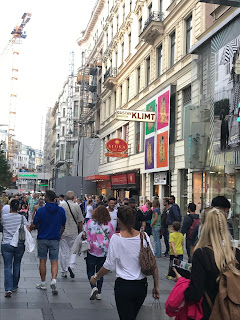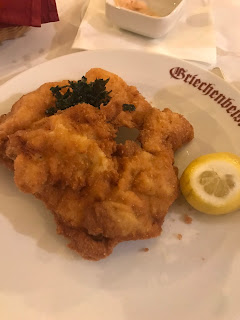A few days after arriving from our summer vacation in
Michigan, my purple suitcase and I were once again reunited - this time
on the way to a conference in Bratislava, Slovakia via Vienna,
Austria. Why via Vienna? Well, Bratislava airport is quite small and it
was more time efficient and cost effective for me to fly thru Vienna or
Budapest, and I was told that Vienna is a must-see city.
 |
| The most important religious building in Vienna, St. Stephen's Cathedral has held many notable events including Mozart's wedding and funeral. |
 |
| Inside the cathedral |
I arrived in Vienna in the middle of the afternoon with only
1 hour of sleep on the plane, but having heard so much about the place from friends and
colleagues, I decided to simply caffeine-up and put on my good walking shoes
even if I feel like a walking zombie. Thankfully, my hotel is located in the
first district, a mere 5-minute walk from Stephanplatz, which is the heart of
the city. The plaza is named after Stephandom, or the St. Stephen's Cathedral,
the well-preserved gothic cathedral sits at the center and is the first stop
for most tourists. The plaza, on the other hand, is filled with tourists and
milling locals alike. This is a favorite spot for locals, especially youth, to
hang out, meet friends, and watch people while enjoying a good, albeit tiny,
cup of coffee at any one of the cafes that lines the plaza. As can be expected,
it was swamped on a Saturday! I’m not going to lie – this scene can be
intimidating for some travelers. It reminds me of Time Square in NY, full of
people from all over the world. The main difference – the plaza is surrounded
by historic buildings instead of tall, glossy skyscrapers. I walked inside the cathedral and was lucky to catch a classical guitar player playing a tune
during the afternoon service.

Like in most cities, tour and concert ticket hawkers abound here. There was a Vivaldi Four Season concert scheduled for that night at the cathedral, which I was so tempted to see. I walked along the pedestrian streets amidst fellow tourists and checked out the shops. One shop in particular caught my eye. It’s a store that had Gustav Klimt reproduction exhibit on the 2nd floor and sold chachkes. The store’s Klimt reproduction exhibit was very good and I bought myself a little music box to add to my personal office fidget toy collection.
The Painted Kiss
I have seen “The Kiss” art reproduced on posters, mugs, etc
but I didn’t know the painting’s title nor the artist, Gustav Klimt – never
heard of him – until the book I borrowed from the library brought the art and
the artist to my attention. While most travelers would buy guidebooks to
prepare for their travels, I typically see my impending travel as an excuse or
inspiration to get lost in a novel and get intimate with the place as a
backdrop to a story. I find that this strategy gives more soul and substance to
the place I’m visiting. While the story may be fictional, the places exist.
 I picked up 2 books – When Nietzche Wept and The Painted
Kiss. Different genres, both well-written. The Painted Kiss is a historical
fiction based on the love story of Viennese painter Gustav Klimt and his muse,
Emilie Floge. Klimt ruled the Viennese art world, founding the Secession, an
art movement formed in 1897 by a group of Austrian artists who had resigned
from the Association of Austrian Artists, housed in the Vienna Künstlerhaus. The book mentions many of the key sights in
Vienna. I was particularly interested in checking out Demel’s, the oldest
operational café in Vienna, established in 1786. Impressive, right?
I picked up 2 books – When Nietzche Wept and The Painted
Kiss. Different genres, both well-written. The Painted Kiss is a historical
fiction based on the love story of Viennese painter Gustav Klimt and his muse,
Emilie Floge. Klimt ruled the Viennese art world, founding the Secession, an
art movement formed in 1897 by a group of Austrian artists who had resigned
from the Association of Austrian Artists, housed in the Vienna Künstlerhaus. The book mentions many of the key sights in
Vienna. I was particularly interested in checking out Demel’s, the oldest
operational café in Vienna, established in 1786. Impressive, right?
The Confessed Chocoholic
 |
| Dense, not-too-sweet, apricot and chocolate concoction - best served with coffee and more chocolate |
I continued walking to Albertina then to Hofburg garden, and
soon it was time for a very late lunch. I went in search of the original Sacher
Torte, perhaps the most famous chocolate cake of all-time, from Hotel Sacher. It was very decadent – 3 layers
of chocolate sponge cake with apricot jam in between and around the cake, then
frosted with a velvety chocolate and served with whipped cream - it didn’t
disappoint. The Sacher coffee with whip cream and chocolate liquor suggested
pairing surprised me, but I didn’t argue with the experts. After all, the hotel
staff have only been making these since 1832!
As the story goes, the cake was created by a 16-year old apprentice cook
for the Prince of Austria because the head chef was sick, and the prince had
ordered that a new cake be created. Franz Sacher created the cake from
available ingredients, and the rest of history was a piece of cake! I
was hoping to see a copy of the original recipe but it’s a well-kept secret,
like the Coke recipe. Nevertheless, I savored my piece of rich heaven along
with the rich history printed on the menu.
I continued my trek and checked out Karlsplatz where some
festival was going on. I was hoping to see a plaque of Vivaldi’s gravesite, but
couldn’t find it, so I headed back to people watch near the State Opera. I was
contemplating on whether to watch an opera or not, but since I was barely
awake, I didn’t want to risk snoring along to Figaro.
 |
| Vienna State Opera at night |
 |
| Gustav Mahler's star on the "walk of fame"; Mahler conducted at the Vienna State Opera. |
If Walls
Could Talk
Whenever I travel, I also try to find the historical
restaurants. It just makes for interesting dining experience to imagine wining
and dining with Beethoven. Plus, apart from the impressively historical building,
menus are fairly established and the service are often reliable – just like a
well-oiled machine. The downside, of course, is the higher cost. Griechebeisl, the oldest restaurant in Vienna,
delivered on all accounts. Griechenbeisl dates back to medieval period. To put
that in perspective, the United States was founded in 1776. By serendipity (hallelujah!),
it was just the next street over from my hotel. I couldn’t make a reservation
at GriechenBeisl. No reservation? Pssshhh! That didn’t stop me from showing up
and sweetly asking if they could seat me. They did, which goes to show that it
never hurts to ask.
When thinking about Vienna, the first food that comes to my
mind is the canned Vienna sausage I used to eat as a kid… Hmmm, I wonder why.
Anyway, it’s super unhealthy, but this was typical household food of my
childhood in the Philippines. Then you have the wiener; Vienna is Wien in
German. Wiener is like a hotdog, frankfurter,
or kielbasa. But when you’re in Vienna, you’ll quickly find out that the most
popular, traditional, non-pastry food is the wiener schnitzel, which has
nothing to do with hotdog. It is a flattened pork dredged in batter and
deep-fried. I was clearly not eating this. Thankfully, Griechenbeisl offered a
chicken version! Now, hubby and I make mean schnitzels, but I had to admit that
this was better than homemade. I saw rosemary in the batter, and made a mental
note to try it the next time I whip a schnitzel at home. Rosemary just makes
everything better.
As good as the food was, the best part was the signature
room, which good, bad or otherwise, seem to be unbeknown to most diners. It was
tucked on the other side of the restaurant, and… empty. I, on the other hand,
did my research well, and not afraid of asking about it. Griechenbeisl has a roomful of signatures of
its prestigious guests – Beethoven, Brahms, Mozart, Schubert, Strauss, Wagner…
Then, you have the modern artists, Pavarotti, Johnny Cash, even Phil Collins.
Their signatures have been memorialized on the walls and ceiling of the Mark
Twain room. Mark Twain’s autograph joins the others. I was completely awed. I
would never have imagined being in the same room as these great artists and
geniuses. It does give me a pause – of all
the greats, I wonder why they chose Twain to name the room after. But more
importantly, I wondered who was composing while they enjoyed their sumptuous
meal. Ah… if walls could talk, indeed.
 |
| Beethoven was here, and now so was I. |
 |
| Zither music with your dinner? Why, yes please! |
 |
| Went to sweet slumber humming Ode to Joy! |


No comments:
Post a Comment